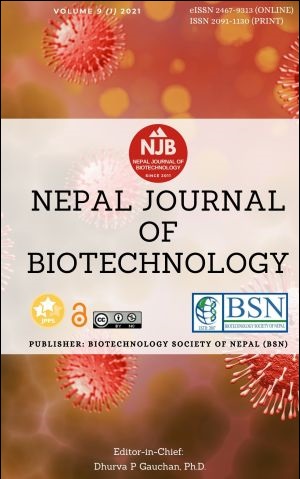Plant and Plant Associated Microflora: Potential Bioremediation Option of Indoor Air Pollutants
DOI:
https://doi.org/10.3126/njb.v9i1.38669Keywords:
Plants, Microorganisms, VOC, Air pollution, Biological remediationAbstract
Indoor air pollution is a significant problem today because the release of various contaminants into the indoor air has created a major health threat for humans occupying indoors. Volatile Organic Compounds (VOCs) are pollutants released into the environment and persist in the atmosphere due to its low boiling point values. Various types of indoor activities, sources, and exposure to outdoor environments enhance indoor VOCs. This poor indoor air quality leads to adverse negative impacts on the people in the indoor environment. Many physical and chemical methods have been developed to remove or decompose these compounds from indoors. However, those methods are interrupted by many environmental and other factors in the indoor atmosphere, thus limit the applications. Therefore, there is a global need to develop an effective, promising, economical, and environmentally friendly alternatives to the problem. The use of the plant and associated microflora significantly impact reducing the environmental VOC gases, inorganic gases, particulate matter, and other pollutants contained in the air. Placing potted plants in indoor environments not only helps to remove indoor air pollutants but also to boost the mood, productivity, concentration, and creativity of the occupants and reduces stress, fatigue, sore throat, and cold. Plants normally uptake air pollutants through the roots and leaves, then metabolize, sequestrate, and excrete them. Plant-associated microorganisms help to degrade, detoxify, or sequestrate the pollutants, the air remediation, and promote plant growth. Further studies on the plant varieties and microorganisms help develop eco-friendly and environmentally friendly indoor air purifying sources.
Downloads
Downloads
Published
How to Cite
Issue
Section
License
Copyright (c) 2021 Biotechnology Society of Nepal

This work is licensed under a Creative Commons Attribution-NonCommercial 4.0 International License.
Copyright Notice:
The manuscript submitted to NJB must be an original contribution, not previously published and should not be under consideration for publication elsewhere. When the manuscript is accepted for publication, the authors agree to automatically transfer the copyright of the article to the publisher. It should grant permission to any third party, in advance and in perpetuity, the right to use, reproduce or disseminate your article, according to the NJB copyright and license agreement.
Authors transfer copyright to the publisher as part of a journal publishing agreement but have the rights to: Share their article for Personal Use, Internal Institutional Use and Scholarly Sharing purposes, with the NJB applies the Creative Commons Attribution-NonCommercial CC BY-NC license to all the works we publish after Jun 2020 (Before it was CC BY-NC-ND). Under this license, authors agree to make articles legally available for reuse, without permission or fees, for virtually any non-commercial purpose. Anyone may remix, adapt, and build upon your work non-commercially, and although their new works must also acknowledge you and be non-commercial, they don’t have to license their derivative works on the same terms. More details on CC BY-NC refer to its Licence Deed and Legal Code.






